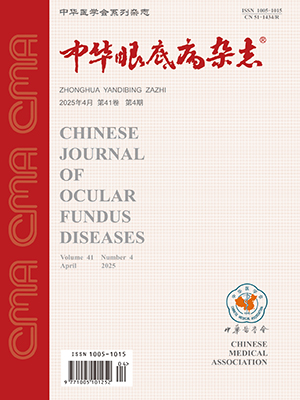| 1. |
Lin Z, Li D, Zhai G, et al. High myopia is protective against diabetic retinopathy via thinning retinal vein: a report from Fushun Diabetic Retinopathy Cohort Study (FS-DIRECT)[J/OL]. Diab Vasc Dis Res, 2020, 17(4): 1479164120940988[2020-07-18]. https://pubmed.ncbi.nlm.nih.gov/32686483/. DOI: 10.1177/1479164120940988.
|
| 2. |
Kim DY, Song JH, Kim YJ, et al. Asymmetric diabetic retinopathy progression in patients with axial anisometropia[J]. Retina, 2018, 38(9): 1809-1815. DOI: 10.1097/IAE.0000000000002109.
|
| 3. |
郭强英, 薛瑢, 万光明. 增生性糖尿病视网膜病变患者眼轴长度及玻璃体腔容积分析[J]. 中华眼外伤职业眼病杂志, 2020, 42(4): 258-261. DOI: 10.3760/cma.j.cn116022-20191028-00353.Guo QY, Xue R, Wan GM. The analysis of axial length and volume of vitreous cavity in patients with proliferative diabetic retinopathy[J]. Chin J Ocul Traum Occupat Eye Dis, 2020, 42(4): 258-261. DOI: 10.3760/cma.j.cn116022-20191028-00353.
|
| 4. |
中华医学会眼科学会眼底病学组. 我国糖尿病视网膜病变临床诊疗指南(2014年)[J]. 中华眼科杂志, 2014, 50(11): 851-865. DOI: 10.3760/cma.j.issn.0412-4081.2014.11.014.Ophthalmology Society of Chinese Medical Association. Clinical guidelines for the diagnosis and treatment of diabetic retinopathy in China (2014)[J]. Chin J Ophthalmol, 2014, 50(11): 851-865. DOI: 10.3760/cma.j.issn.0412-4081.2014.11.014.
|
| 5. |
David VP, Stead RE, Vernon SA. Repeatability of ocular response analyzer metrics: a gender-based study[J]. Optom Vis Sci, 2013, 90(7): 691-699. DOI: 10.1097/OPX.0b013e318297da45.
|
| 6. |
Kashim RM, Newton P, Ojo O. Diabetic retinopathy screening: a systematic review on patients' non-attendance[J]. Int J Environ Res Public Health, 2018, 15(1): 157. DOI: 10.3390/ijerph15010157.
|
| 7. |
朱鸿, 朱耀春, 胡海林, 等. 糖尿病视网膜病变相关临床和生物化学指标的监测和预警意义[J]. 中华眼底病杂志, 2012, 28(3): 219-223. DOI: 10.3760/cma.j.issn.1005-1015.2012.03.003.Zhu H, Zhu YC, Hu HL, et al. A joint diagnostic test to assess the clinical risk factors of diabetic retinopathy[J]. Chin J Ocul Fundus Dis, 2012, 28(3): 219-223. DOI: 10.3760/cma.j.issn.1005-1015.2012.03.003.
|
| 8. |
于荣国, 张慧, 张晓敏, 等. 糖尿病视网膜病变患者循环外泌体中炎症相关蛋白S100A8的表达[J]. 中华眼底病杂志, 2021, 37(1): 32-39. DOI: 10.3760/cma.j.cn511434-20200616-00285.Yu RG, Zhang H, Zhang XM, et al. Circulating exosomal inflammation-related protein S100A8 as a potential biomarker for the severity of diabetic retinopathy[J]. Chin J Ocul Fundus Dis, 2021, 37(1): 32-39. DOI: 10.3760/cma.j.cn511434-20200616-00285.
|
| 9. |
Sorrentino FS, Matteini S, Bonifazzi C, et al. Diabetic retinopathy and endothelin system: microangiopathy versus endothelial dysfunction[J]. Eye (Lond), 2018, 32(7): 1157-1163. DOI: 10.1038/s41433-018-0032-4.
|
| 10. |
Durukan I. Corneal endothelial changes in type 2 diabetes mellitus relative to diabetic retinopathy[J]. Clin Exp Optom, 2020, 103(4): 474-478. DOI: 10.1111/cxo.12971.
|
| 11. |
Cankaya C, Kalayci BN. Corneal biomechanical characteristics in patıents with Behçet disease[J]. Semin Ophthalmol, 2016, 31(5): 439-445. DOI: 10.3109/08820538.2014.962168.
|
| 12. |
Pillunat KR, Hermann C, Spoerl E, et al. Analyzing biomechanical parameters of the cornea with glaucoma severity in open-angle glaucoma[J]. Graefe's Arch Clin Exp Ophthalmol, 2016, 254(7): 1345-1351. DOI: 10.1007/s00417-016-3365-3.
|
| 13. |
Xu G, Chen Z. Corneal hysteresis as a risk factor for optic nerve head surface depression and retinal nerve fiber layer thinning in glaucoma patients[J/OL]. Sci Rep, 2021, 11(1): 11677[2021-06-03]. https://pubmed.ncbi.nlm.nih.gov/34083548/. DOI: 10.1038/s41598-021-90588-7.
|
| 14. |
Scheler A, Spoerl E, Boehm AG. Effect of diabetes mellitus on corneal biomechanics and measurement of intraocular pressure[J/OL]. Acta Ophthalmol, 2012, 90(6): e447-e451[2012-06-13]. https://pubmed.ncbi.nlm.nih.gov/22691299/. DOI: 10.1111/j.1755-3768.2012.02437.x.
|
| 15. |
Ramm L, Herber R, Spoerl E, et al. Factors influencing corneal biomechanics in diabetes mellitus[J]. Cornea, 2020, 39(5): 552-557. DOI: 10.1097/ICO.0000000000002275.
|
| 16. |
Beato JN, Esteves-Leandro J, Reis D, et al. Structural and biomechanical corneal differences between type 2 diabetic and nondiabetic patients[J/OL]. J Ophthalmol, 2019, 2019: 3764878[2019-03-18]. https://pubmed.ncbi.nlm.nih.gov/31011451/. DOI: 10.1155/2019/3764878.
|
| 17. |
Salami MO, Aribaba OT, Musa KO, et al. Relationship between corneal sensitivity and diabetic retinopathy among diabetics attending a Nigerian Teaching Hospital[J]. Int Ophthalmol, 2020, 40(10): 2707-2716. DOI: 10.1007/s10792-020-01456-8.
|
| 18. |
Taşlı NG, Icel E, Karakurt Y, et al. The findings of corneal specular microscopy in patients with type-2 diabetes mellitus[J]. BMC Ophthalmol, 2020, 20(1): 214. DOI: 10.1186/s12886-020-01488-9.
|
| 19. |
Sanchis-Gimeno JA, Alonso L, Rahhal M, et al. Corneal thickness differences between type 2 diabetes and non-diabetes subjects during preoperative laser surgery examination[J]. J Diabetes Complications, 2017, 31(1): 209-212. DOI: 10.1016/j.jdiacomp.2016.08.024.
|
| 20. |
Capitão M, Soares R. Angiogenesis and inflammation crosstalk in diabetic retinopathy[J]. J Cell Biochem, 2016, 117(11): 2443-2453. DOI: 10.1002/jcb.25575.
|
| 21. |
Ramm L, Herber R, Spoerl E, et al. Measurement of corneal biomechanical properties in diabetes mellitus using the ocular response analyzer and the Corvis ST[J]. Cornea, 2019, 38(5): 595-599. DOI: 10.1097/ICO.0000000000001879.
|
| 22. |
Del Buey MA, Casas P, Caramello C, et al. An update on corneal biomechanics and architecture in diabetes[J/OL]. J Ophthalmol, 2019, 2019: 7645352[2019-06-02]. https://pubmed.ncbi.nlm.nih.gov/31275634/. DOI: 10.1155/2019/7645352.
|
| 23. |
Altan C, Demirel B, Azman E, et al. Biomechanical properties of axially myopic cornea[J]. 2012, 22 Suppl 7: S24-28. DOI: 10.5301/ejo.5000010.
|
| 24. |
İnceoğlu N, Emre S, Ulusoy MO. Investigation of corneal biomechanics at moderate to high refractive errors[J]. Int Ophthalmol, 2018, 38(3): 1061-1067. DOI: 10.1007/s10792-017-0560-0.
|
| 25. |
Gaspar R, Pinto L A, Sousa DC. Corneal properties and glaucoma: a review of the literature and meta-analysis[J]. Arq Bras Oftalmol, 2017, 80(3): 202-206. DOI: 10.5935/0004-2749.20170050.
|
| 26. |
Yazgan S, Celik U, Kaldırım H, et al. Evaluation of the relationship between corneal biomechanic and HbA1C levels in type 2 diabetes patients[J]. Clin Ophthalmol, 2014, 8: 1549-1553. DOI: 10.2147/OPTH.S67984.
|




